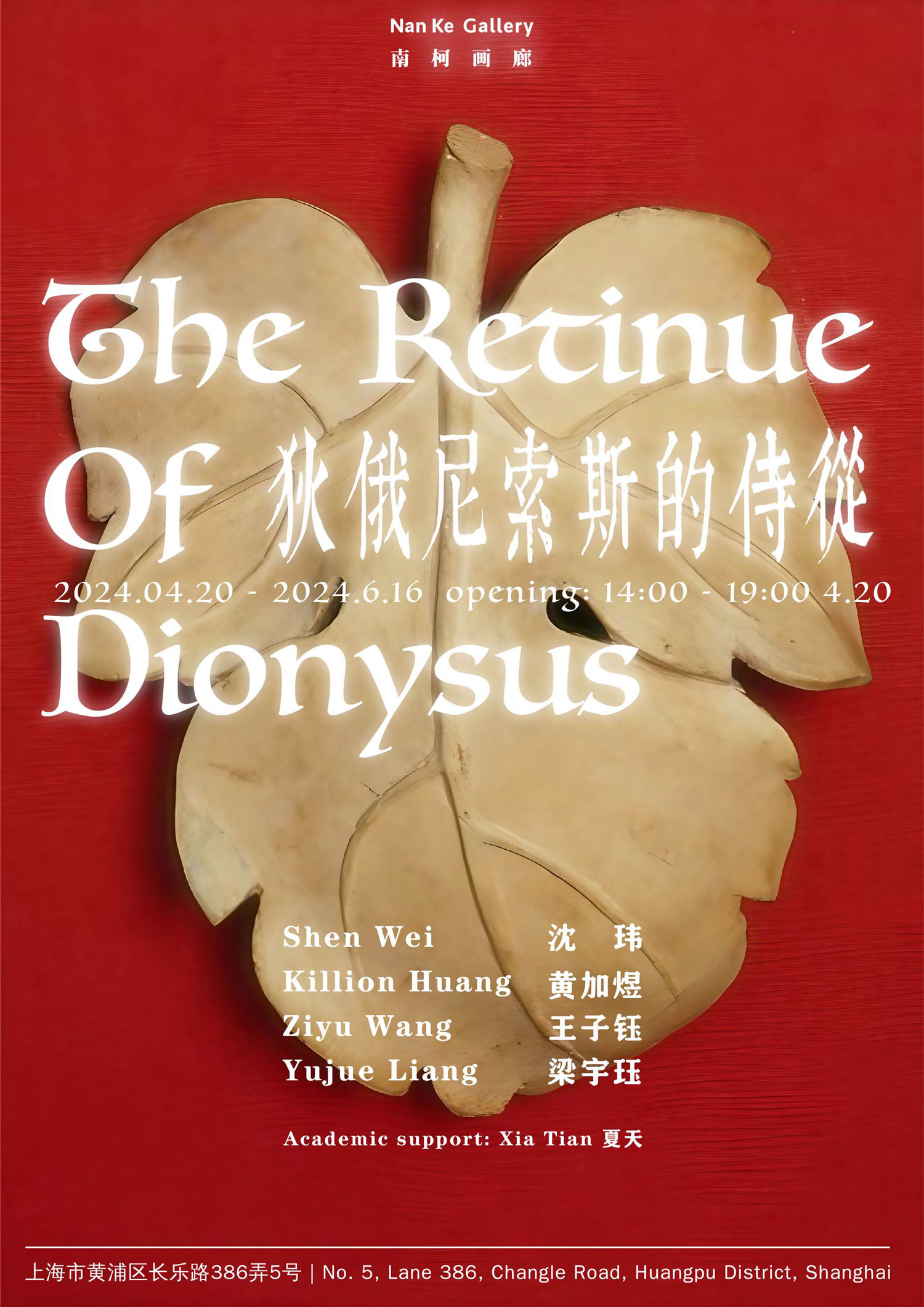展期 Period:
2024.4.20—2024.6.16
艺术家 Artist:
梁宇珏 Liang Yujue、黄加煜 Killion Huang、沈玮 Shen Wei、王子钰 Wang Ziyu
学术支持 Academic Support:
夏天 Xia Tian
地点 Venue:
新闻稿 Press Release:
南柯画廊将于4月20日带来群展项目“狄俄尼索斯的侍从”(The Retinue of Dionysus)。展览标题来源于希腊诗人卡瓦菲斯(Constantine P. Cavafy)的同名诗篇。参与本次展览的四位艺术家分别是沈玮、黄加煜、王子钰与梁宇珏。在不同程度上,本次展览所选择的摄影、绘画以及装置作品所质疑的是传统社会规范中父权或霸权式的“男性气质”。
“男性气质”(Masculinity)的含义变迁可以追溯到1990年代的学术转向。在大卫·吉尔摩(David Gilmore)等学者看来,“男性气质”同“性别”一样,是一种文化建构的产物。如今,它已成为一个具有流动性质的概念,研究者意图使其摆脱以“力量”为核心而构建起来的具有垄断地位的定见。正如卡瓦菲斯的诗歌所表露的那样,本次展览旨在通过视觉艺术的方式来思考当代男性形象背后的多元含义。
沈玮的作品展示了人类的肉体与自然景观的映衬关系,这些精美的照片重新塑造了美感与男性身体之间的审美期待。它们颠覆了对于“男性身体”及其表征的惯例——譬如,以极致的秩序为典范的集权美学——因为,在某种社会预设中,粗野或臣服的男性气质得到了默许的赞扬。然而,在沈玮的作品中——譬如《Untitled (D5059)》(2019)——去性别化的脚踝或许要比我们所想象的要更显爱欲。这些细腻的姿势或体态暗示了性别的模糊性,将传统语境下的“男性气质”弱化、拆解,彰显更具有在性别框架下的流动性的个体化与私密感。
在黄加煜的绘画当中,艺术家会将半裸的男性(与猫咪)至于狭小而复杂的室内场景之中,并且,这些红色作品在局部与细节上力求展现出过渡、转化或者炫目的视觉效果。画面的取景范围很小,观众可以设身处地地想象如下这一场景:与一位逗弄猫咪的男性共处一室。这些绘画具有非暴力的特点——在笔触与主题的双重意义上——同时还展现了一种男性在“自我塑造”与“自我呵护”之间的模糊界限。这一含义表现在作品《仪式》(2024)当中:画中人物托举起猫咪的双手同时具有塑形与保护的意味。
王子钰的摄影作品大多都以自我形象作为主角。在作品中,“男主角”似乎是热衷于自拍的调皮男生。他的目光通常都直面观众,很有可能,艺术家将投射在作品形象中的目光设定成了父权制的凝视。在这里,观众将会看到一个由艺术家所塑造的“完美儿子”的形象,他以轻松而戏谑的态度在真实的自我上重建出一个父亲眼中的“好儿子”的外壳,并以此精确地讽刺了传统家庭伦理中对于孩子虚假形象的期冀。作品中,男生手中的快门线同时暗示了艺术家对于性别意识与作者身份的控制权。在作品《小伙子们》(2023)中,艺术家借助喜剧化的排列方式——自左至右男性形象身高与体态的渐变——表明“男性”概念内部所具有的多元性。
梁宇珏的作品《新物种》(2023)受到底特律音乐家马修·德尔(Matthew Dear)的启发,通过融合与汽车和科技相关的制作材料,创造出关于传统男性力量中“男人与马”这一经典情境的讨论和反思。本次展览呈现了一组由碳纤维和3D打印制成的装置。这件黑色的脊椎式的器官缺乏外在柔性的包裹,它脱离了肉身和由此生发的有关“男性身份”这一框架的有限性,并展示出了一种异质的“韧度”。在展览的语境中,作品通过在内容上强调男性气质的“内在性”和形式上强调其“外在的标签属性”营造出戏剧般的冲突,揭露了有关男性霸权的悖论。
事实上,前卫艺术史中的杜尚早已触及了“男性气质”的议题。杜尚的异妆分身——Rrose Sélavy——被艺术家曼·雷的镜头所记录。在美国,杜尚的信徒们——约翰·凯奇、罗伯特·劳申伯格、贾斯帕·约翰斯、安迪·沃霍尔——扩展了杜尚对于“性别”视角的描述,在绘画、剧场和摄影媒介中将其修正为了更具本源性的艺术矩阵:这些艺术家不再选择扮演“女性”,而是选择成为“自己”。在英国,弗朗西斯·培根与大卫·霍克尼绘画中的肉体与白袜进一步增添了这一美学的可见性。对于身处全球化时代的中国艺术家而言,策略性的选择将不得不聚焦于更为具体的激进路径。首先,他们自然而然地接续起了西方艺术史前例,并且,他们仍需更进一步地在全球迁徙与亚洲身份之中发现自我表达的复杂性。
Nan Ke Gallery will present the group exhibition project 'The Retinue of Dionysus' on April 20th. The exhibition title is derived from the poem of the same name by the Greek poet Constantine P. Cavafy. The four artists participating in this exhibition are Shen Wei, Huang Jiayu, Wang Ziyu, and Liang Yujue. To varying degrees, the photography, painting, and installation works selected for this exhibition question the patriarchal or hegemonic 'masculine qualities' present in traditional social norms.
The evolution of the meaning of 'masculinity' can be traced back to the academic shift of the 1990s. Scholars like David Gilmore argue that 'masculinity,' like 'gender,' is a cultural construct. Today, it has become a fluid concept, with researchers aiming to break away from the monopolistic views constructed around 'power' as its core. As revealed in Cavafy's poetry, this exhibition aims to contemplate the diverse meanings behind contemporary male images through visual arts.
Shen Wei's works display the juxtaposition between the human body and natural landscapes, these exquisite photographs reshape the aesthetic expectations between beauty and the male body. They subvert the conventions regarding the 'male body' and its representations—for example, the authoritarian aesthetics exemplified by extreme order—because, in certain societal presets, rugged or submissive male qualities are tacitly praised. However, in Shen Wei's works—such as 'Untitled (D5059)' (2019)—the gender-neutral ankles perhaps exude more sensuality than we might imagine. These delicate postures or gestures imply the ambiguity of gender, weakening and deconstructing the 'masculine qualities' in traditional contexts, highlighting a more fluid individuality and intimacy within the framework of gender.
In Killion Huang's paintings, the artist places semi-nude men (along with cats) in cramped and intricate indoor scenes. Moreover, these red artworks strive to present transitional, transformative, or dazzling visual effects in their details and partial views. The scenes depicted are narrow in scope, allowing viewers to imagine themselves in such scenarios: sharing a room with a man playing with a cat. These paintings possess a non-violent characteristic—both in brushwork and theme—while also displaying a blurred boundary between a man's 'self-shaping' and 'self-care.' This significance is portrayed in the artwork 'Ceremony' (2024): the figure in the painting holding the cat's hands aloft simultaneously conveys a sense of shaping and protection.
Most of Ziyu Wang's photographic works feature self-portraits as the protagonist. In these works, the 'male protagonist' appears to be a mischievous boy keen on taking selfies. His gaze often directly confronts the audience, and it is quite possible that the artist has set the gaze projected onto the images as a patriarchal gaze. Here, the audience will see an image of the 'perfect son' crafted by the artist, who reconstructs, with a relaxed and playful attitude, the shell of a 'good son' in the eyes of a father on his true self, thus precisely satirizing the expectations of false images of children in traditional family ethics. In the work, the shutter release cable in the boy's hand also suggests the artist's control over gender consciousness and authorship identity. In the work 'Lads' (2023), the artist uses a comedic arrangement—gradual variations in the height and physique of male figures from left to right—to indicate the diversity inherent within the concept of 'masculinity'.
Yujue Liang's work 'New Breed' (2023) is inspired by the Detroit musician Matthew Dear, creating a discussion and reflection on the classic scenario of 'man and horse' within traditional male power by merging materials related to cars and technology. The exhibition presents a series of installations made from carbon fiber and 3D printing. This black, spine-like organ lacks external flexible wrapping, detaching itself from the limitations of the flesh and the framework of 'male identity' derived from it, and showcasing a kind of heterogeneous 'resilience.' Within the context of the exhibition, the work creates dramatic conflicts by emphasizing the 'internal' aspects of masculinity in content and the 'external labeling attributes' in form, revealing the paradoxes of male hegemony.
In fact, the topic of 'masculinity' has long been touched upon in the history of avant-garde art. Duchamp's alter ego—Rrose Sélavy—was documented by the lens of the artist Man Ray. In the United States, Duchamp's disciples—John Cage, Robert Rauschenberg, Jasper Johns, Andy Warhol—expanded Duchamp's perspective on 'gender,' refining it into a more intrinsic artistic matrix in painting, theater, and photography: these artists no longer chose to portray 'femininity,' but instead chose to be 'themselves.' In Britain, the depiction of the body and white socks in the paintings of Francis Bacon and David Hockney further enhanced the visibility of this aesthetic. For Chinese artists in the era of globalization, strategic choices will inevitably focus on more specific and radical paths. Firstly, they naturally continue the precedent of Western art history, and secondly, they still need to further explore the complexity of self-expression in the context of global migration and Asian identity.

